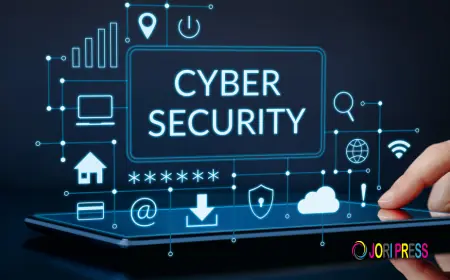Cybersecurity in the Age of AI Cloning and Deepfakes: What’s Your Business Risk in 2025?
In this blog post, I’m going to talk about how these emerging threats—particularly AI cloning and deepfakes—are reshaping the cybersecurity landscape, and why your business needs to be prepared. Whether you’re running a big company or a small startup, understanding these risks and taking proactive steps can make all the difference in 2025.
As we move into 2025, the world of cybersecurity is facing new and unexpected challenges. Gone are the days when all we had to worry about were basic hacks and data breaches. Today, AI-driven threats like deepfakes and AI cloning are rapidly becoming mainstream, and they’re not just affecting celebrities—they’re putting businesses, startups, and even individuals at risk in ways we’ve never imagined before.
The rise of artificial intelligence has brought about amazing advancements, but it’s also opened the door to a new wave of malicious activity that can have severe consequences on a company’s reputation, trust, and bottom line. In fact, the risks are so serious that it’s now essential for every business to rethink their cybersecurity strategies.
The Problem: The New Face of Cybersecurity Threats
If you’ve ever seen a deepfake video or heard of AI clones impersonating real people, you probably know how convincing they can be. But what does this mean for the average business, and why should you care? Here’s the thing: AI cloning and deepfakes aren’t just about hoaxes or viral videos anymore—they can be used for sophisticated cyberattacks.
Deepfakes and AI Cloning: A New Breed of Cyber Threats
At their core, deepfakes are hyper-realistic videos, images, or audio recordings that are manipulated using AI. What makes them so dangerous is that they’re nearly impossible for the average person to detect as fake. Someone can clone a CEO’s voice and ask for confidential information, or fake a video of an employee making a controversial statement, all to damage your company’s reputation or steal sensitive data.
AI cloning is just as risky. In the context of cybersecurity, it refers to using AI to impersonate individuals in various forms. Whether it’s mimicking a person’s voice, mannerisms, or even email writing style, AI cloning can trick your team into divulging sensitive information or transferring funds to fraudulent accounts. It’s essentially digital identity theft at its finest.
The Stakes for Businesses in 2025
In 2025, businesses will face the perfect storm of challenges in cybersecurity. AI technology will be widely available, and so will the tools to exploit it. This means that attacks can be executed with unprecedented speed, scale, and sophistication. Here’s what’s at risk for your business:
-
Brand Reputation: A deepfake video of your CEO making false claims could destroy years of hard work building trust with your customers.
-
Data Theft: AI cloning could allow hackers to impersonate key employees and gain access to your company’s sensitive data or financial accounts.
-
Operational Disruptions: Deepfake videos could lead to mass panic, misinformation, or disinformation campaigns that could harm your business’s operations.
If you think this won’t affect you, think again. The more your business relies on digital presence, the more vulnerable you are to these kinds of attacks. So, how can you protect yourself?
The Solution: How to Safeguard Your Business in the Age of AI
You can’t rely on traditional cybersecurity methods alone in 2025. With deepfakes and AI cloning becoming increasingly sophisticated, businesses need to rethink their approach. Here are some practical steps you can take to bolster your cybersecurity efforts:
Step 1: Build Stronger Identity Verification Systems
If you haven’t already, now’s the time to implement robust identity verification protocols across your business. One of the most effective ways to prevent AI cloning and impersonation is by using multi-factor authentication (MFA).
MFA requires users to provide two or more verification factors—such as passwords, biometric scans, or hardware tokens—to access sensitive information. By doing this, you create an extra layer of protection that deepfakes and AI cloning can’t easily bypass.
For example, if a hacker successfully mimics an executive’s voice or writing style, MFA would still block unauthorized access by requiring something more than just their cloned identity.
Step 2: Train Employees on Deepfake Detection
The best defense against deepfakes often comes down to education. Many employees, especially those not in tech, may not even know deepfakes are a thing, let alone how to spot them.
-
Regular Training: Hold regular sessions on how to spot deepfake videos, audio, and phishing emails.
-
Fake Media Alerts: Encourage employees to be cautious when viewing media or audio from unofficial sources, especially if it includes requests for confidential information or actions.
-
Verification Tools: Provide tools for employees to verify the authenticity of digital content before acting on it. Some companies offer AI-driven solutions that can detect deepfakes by analyzing metadata and inconsistencies in the video or audio.
In a world where deepfake technology is rapidly advancing, it’s essential that your staff knows how to spot these threats before they fall for them.
Step 3: Monitor and Protect Your Digital Presence
Your digital footprint is one of your business’s greatest assets—and also one of its biggest liabilities. If hackers gain access to your website, social media profiles, or email accounts, they can use AI-driven tools to create fake profiles or generate false content that damages your reputation.
To prevent this, you need to actively monitor your online presence. Here’s how:
-
AI-powered Monitoring: Use AI-powered tools to monitor your brand’s reputation online. These tools can alert you to any fake content, impersonations, or malicious activity that could harm your business.
-
Control Your Digital Content: Be proactive about controlling the digital content that represents your brand. This means setting up strong security for your website, social media accounts, and other online platforms.
If you’re curious about the vape shops open near me, keeping an eye on online reviews and content about your business will help you avoid misinformation or deepfake content that could hurt your reputation.
Step 4: Stay Ahead with Cutting-Edge AI and Blockchain Solutions
As AI threats evolve, so too must our defenses. In 2025, AI-powered cybersecurity tools will be essential in identifying, preventing, and responding to attacks in real time. Companies are already using AI-enhanced firewalls and machine learning algorithms to detect unusual patterns of behavior that could indicate a breach.
On top of that, blockchain technology can provide an added layer of security to help verify the authenticity of digital assets. By using blockchain’s decentralized ledger system, businesses can ensure that the information they receive—from financial transactions to digital content—has not been altered or tampered with.
Step 5: Be Prepared for the Worst with Crisis Management Plans
While it’s impossible to prevent every cyberattack, you can certainly prepare for the worst. In the event of a deepfake or AI cloning attack, it’s crucial to have a crisis management plan in place.
-
Immediate Response: Have a team ready to handle the situation, whether that means taking down fake content, issuing public statements, or contacting law enforcement.
-
Customer Communication: Prepare a communication strategy for informing your customers about the situation. Transparency is key to maintaining trust during a crisis.
-
Legal Action: Work with legal experts to understand your rights and potential actions against those behind the AI cloning or deepfake.
Having a crisis management plan isn’t just about minimizing the damage—it’s also about reassuring your customers and partners that your business is resilient and can recover from any attack.
The Risk of Inaction: What Happens If You Don’t Prepare?
It’s easy to think that these advanced cyber threats are something for larger companies to worry about, but deepfakes and AI cloning affect businesses of all sizes. If you don’t take the necessary precautions, you risk:
-
Losing customer trust if a deepfake video falsely implicates your brand.
-
Financial losses due to fraudulent transactions or stolen intellectual property.
-
Damaged brand reputation that can take years to recover from.
Even if you're running a smaller operation, your business is still a target, and the consequences of not preparing could be catastrophic. For example, if you were to smoke vape in front of your customers while discussing cybersecurity, and an AI-generated clip made it seem like you were endorsing illegal activities, it would erode trust and alienate potential customers.
The Future: Stay Vigilant in the Age of AI
As we approach 2025, one thing is clear: cybersecurity needs to evolve along with technology. AI, deepfakes, and AI cloning aren’t just buzzwords—they’re real threats that businesses need to address now. By implementing robust security measures, educating your employees, and preparing for potential crises, you can protect your company from the worst that AI has to offer.
The risk is real, but so is the opportunity to build a resilient and secure business that’s ready for the challenges of tomorrow. Take action now, and you’ll be one step ahead of the game.
What's Your Reaction?
 Like
0
Like
0
 Dislike
0
Dislike
0
 Love
0
Love
0
 Funny
0
Funny
0
 Angry
0
Angry
0
 Sad
0
Sad
0
 Wow
0
Wow
0



















































